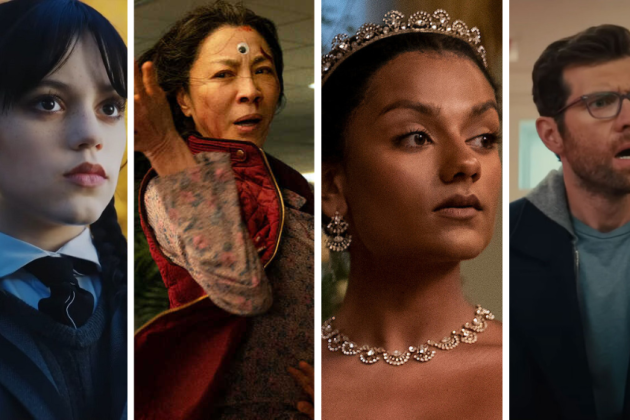Intersectionality Grows On Screen But Diversity In Film & TV Sees Minimal Overall Changes In 2022 — Report

Hollywood is increasingly taking intersectionality into account when creating stories for film and TV, despite minimal overall improvement regarding representation for marginalized groups in the last two years, according to Luminate’s latest Entertainment Diversity Progress Report.
The report, released on Monday, was last published in 2021. Since then, “the idea that each individual is defined by multiple identities across race, gender, ethnicity, sexuality, ability, etc., is a reality that seems to be increasingly taken into consideration by Hollywood’s content creators, allowing films and series to better explore and reflect the nuances of the human experience.”
More from Deadline
But that doesn’t necessarily indicate that diversity is increasing on screen overall. In fact, Luminate reports that there was minimal growth or change (if any) for several underrepresented groups, including Latinx, Indigenous, and Middle Eastern/North African people.
Broken down even further, Luminate’s report points out several discrepancies in the diversity on screen. While main title roles held by Black actors increased by over 20% in 2022, the number of movies with Black stories at the forefront decreased by 16.7% (to make up only 5.3% of movies released in 2022).
Similarly, despite being one of the fastest growing segments of the U.S. population, Hispanic representation has seen decreases both in front of and behind the camera in film and TV. Over the past two years, main title roles held by Hispanic talent decreased from 8.7% to 7.7%, while and director roles held by Hispanic talent decreased to 4.6% (down from 6.8% in 2021). The number of movies that actually center Latino narratives is even lower, with 6 films in 2022 or only 0.9% of all movies released that year.
Indigenous representation remains “remarkably low,” according to Luminate. In film, only 1.7% of main title cast identifying as Indigenous. As for series, 2.3% of series regulars in 2022 identified as Indigenous (up from 2% in 2021), and there were 10 Indigenous series creators in 2022 (representing 2.2% of all series creators). Of films that were released in 2022, only 1.8% of all main title cast roles were held by Middle Eastern or North African actors, and only 1.7% of all film directors that year were of that background.
The report states that Asian representation in film and series has increased in 2022. The total number of Asian main title cast and directors in film grew to 18.5% and 13.5%, respectively — meaning that Asian talent represented 7.7% of all main title cast roles and 5.9% of directors roles. However, only 1.8% of all movies released in 2022 centered on Asian stories.
Luminate has also spotted other diversity related trends over the past two years, including the proliferation of non-English language content availability in the United States, which has been driven by streaming platforms. The report points to Netflix as an example, having an “outsized impact” on foreign-language content representation.
According to the report, Netflix distributes film and TV that accounts for between 17% to 28% of all series regular roles for Latin/Hispanic, Asian, and Middle Eastern/North African talent in the U.S.
In the past two years, Amazon and Disney+ have also stepped up in terms of foreign-language content.
However, the report is also quick to point out that, while this is a positive development for foreign-language content, it also doesn’t solve problems related to the lack of diverse domestic casting, and it has the potential to segregate talent from diverse ethnic groups to non-English-language content.
The report also shows growth for women in both film director and series creator roles in 2022. But gender diversity on screen has been more of a mixed bag. From 2021 to 2022, the percentage of main title film roles played by women increased from 41% to 42.7% of the total roles that existed, while the percentage of series regulars played by women has decreased from 46.3% to 45.7%.
LGBTQ+ representation in film is growing, but it is still relatively low. The number of main title roles in film increased from 3.4% in 2021 to 3.9% of all main title roles in 2022. However, when you look at the percentage of movies that have a main title LGBTQ+ actor, it decreased from 18.3% in 2021 to 17% in 2022.
Luminate wrote that the disabled community was “by far and away the worst out of all the groups” that were analyzed. Since disabilities can be difficult to identify, the data set can only rely on talent that has publicly stated that they are part of a disability community. Of those, the report found only 0.5% of films in the past two years had a main title cast member with a disability.
“One of our primary goals in creating the Entertainment Diversity Progress Report is to provide respectful, objective and accurate information to help drive the much needed change around diversity and inclusion in Hollywood. Our partners depend on our broader DEI dataset to measure internal progress, benchmark and identify talent that can ensure authentic and respectful storytelling. When looking at the data in this most recent report, we encourage all of our partners in Hollywood to celebrate the gains that have been made, like growth in female director roles and female series creators, while also urging them to take a look at places where growth was not seen, like films and series with Black and Latin/Hispanic stories at the forefront,” said Mark Hoebich, EVP, Head of Luminate Film & TV.
Best of Deadline
Hollywood & Media Deaths In 2023: Photo Gallery & Obituaries
2023 Premiere Dates For New & Returning Series On Broadcast, Cable & Streaming
Sign up for Deadline's Newsletter. For the latest news, follow us on Facebook, Twitter, and Instagram.

